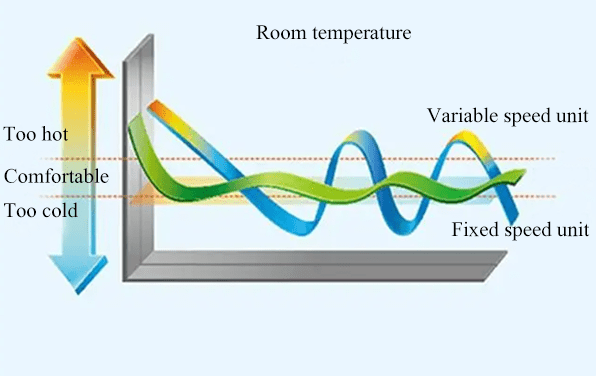
Parameters such as air conditioning horsepower, fixed frequency/variable frequency, energy efficiency ratio, and refrigerant can be clearly seen on the product detail page, so for novices, after understanding the parameters mentioned above, they can truly read the product detail page.
1. Types of Air Conditioning Systems
● According to their functions, air conditioning systems are divided into air conditioners (cooling only), heat pumps (heating and cooling), and air handlers.
● According to the installation method, they are divided into wall-mounted units and tower units.
● According to whether the refrigeration compressor speed is variable, they are divided into fixed speed and variable speed units.
● According to the product form, they are divided into split type and packaged type.
This article briefly talks about cooling only type air conditioners, heat pumps, and air handlers.
1.1 Air Conditioner
As the name suggests, cooling only type air conditioners are mainly used for summer cooling and are suitable for areas where the weather is not very cold in winter.
1.2 Heat Pump
Compared with cooling only type air conditioners, heat pumps have an additional four-way valve (4-way reversing valve). It has four ports, which are connected to the discharge port, suction port, evaporator and condenser of the compressor respectively, equivalent to a device for switching flow paths. When cooling or heating, the valve core of the four-way valve is controlled to be in different positions, thereby controlling the flow direction of the refrigerant and realizing the conversion of cooling and heating functions.

1.3 Air Handler
To be precise, the air handler mentioned here is a new generation of the traditional version. It integrates multiple devices such as air conditioners, fresh air ventilators, humidifiers, dehumidifiers, air purifiers, and air disinfection machines, and becomes a highlight in the high-end market. Generally, the upper part is air conditioning, and the lower part is fresh air and purification systems.
Air handlers are suitable for people with sufficient budgets and high requirements for air quality, and families with the elderly and children, and pets.

2. Horsepower Selection
The horsepower represents a power unit, which indicates the cooling capacity of the air conditioning system. Usually, 1 horsepower = 2500W. Common horsepower units include "1 horsepower", "1.5" horsepower, "2 horsepower", "3 horsepower", etc.
Although, the larger the house, the more cooling capacity is required. But when we choose the air conditioning horsepower, we can't just consider the size of the room, but also combine the climate conditions, floor height, room height, room sealing, floor-to-ceiling window area, family size, room purpose (kitchen) and other factors to decide.
3. Choose Variable Speed or Fixed Speed
The biggest difference between fixed speed and variable speed air conditioning units is that they work differently. Variable speed air conditioning systems will automatically adjust the working speed of the compressor when running. When the indoor temperature reaches the preset temperature, the compressor will automatically run at a low speed. When the indoor temperature difference is large, the compressor will automatically change from low speed to high speed, so that the room temperature is always in a constant state, and it will not be too hot and too cold.
In terms of the compressor running speed, the fixed speed air conditioning system will only output power at one speed. When the room temperature reaches the preset temperature, it will stop running, and then continue to work after the room temperature rises, so that the room temperature will fluctuate.
In the selection of home appliances, choosing variable speed instead of fixed speed has also become a consensus among consumers, because variable speed appliances are more energy-saving than fixed speed appliances.
The excellent performance of variable speed air conditioning systems makes them mainstream. The variable speed air conditioning systems feature softer air output and lower noise, and it makes the room temperature constant, the body temperature comfortable, and the chance of Sick Building Syndrome (SBS) reduced. Especially when you sleeping at night, the advantages of speed air conditioning systems are more obvious.

4. Energy Efficiency Ratio
SEER stands for Seasonal Energy Efficiency Ratio. It is a measure of the cooling efficiency of an air conditioner or heat pump. The SEER rating is calculated by dividing the cooling output of the unit over a typical cooling season by the energy it consumes in watt-hours.
A higher SEER rating indicates greater energy efficiency, meaning the unit can provide more cooling output for each unit of electricity it consumes.
5. Other Important Parameters
5.1 Refrigerant
Common refrigerants include R22, R410a, and R32. R22 is listed as one of the banned refrigerants in the Montreal Protocol because it has a very high potential to destroy the ozone layer.
5.2 Self-Cleaning Technology
If the air conditioning system is not cleaned for a long time, a large number of bacteria, mold and dirt will grow inside. Choose an air conditioning system with self-cleaning technology for internal and external units to eliminate attached bacteria, wash away dust on the surface of the heat exchanger, improve cooling and heating efficiency, and ensure stable operation of the air conditioning system.

5.3 Smart Sleep Mode
Smart sleep mode is a new technology launched by air conditioner / heat pump manufacturers for nighttime sleep. It mainly ensures a comfortable, quiet, and light-free sleeping environment by intelligently controlling the temperature curve, noise level, screen display (photosensitive technology) of the air conditioning system at night. It is suitable for people with sleep disorders.
5.4 Smart Control Operation

Common smart functions include remote power on/off, customized sleep curve, whole-home smart linkage, etc. Among them, remote power on/off means that you can turn the machine on and off through the mobile phone APP at any time and anywhere, without worrying about forgetting to turn off the power when you are in a hurry to go out.


